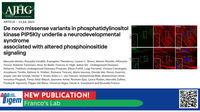Authors: Manuela Morleo, Rossella Venditti, Evangelos Theodorou, Lauren C. Briere, Marion Rosello, Alfonsina Tirozzi, Roberta Tammaro, Nour Al‐Badri, Frances A. High, Jiahai Shi , Undiagnosed Diseases Network, Telethon Undiagnosed Diseases Program, Elena Putti5, Luigi Ferrante, Viviana Cetrangolo, Annalaura Torella, Melissa A. Walker, Romano Tenconi, Maria Iascone, Davide Mei, Renzo Guerrini, Jasper van der Smagt, Hester Y. Kroes, Koen L. I. van Gassen, Muhammad Bilal, Muhammad Umair, Veronica Pingault, Tania Attie‐Bitach, Jeannine Amiel, Resham Ejaz, Lance Rodan, Marcella Zollino, Pankaj B. Agrawal, Filippo Del Bene, Vincenzo Nigro, David A. Sweetser4 and Brunella Franco.
Year: 2023
Sources: The America Journal of Human Genetics
Abstract:
Phosphoinositides (PIs) are membrane phospholipids produced through the local activity of PI kinases and phosphatases that selectively add or remove phosphate groups from the inositol head group. PIs control membrane composition and play key roles in many cellular processes including actin dynamics, endosomal trafficking, autophagy, and nuclear functions. Mutations in phosphatidylinositol 4,5 bisphosphate [PI(4,5)P2] phosphatases cause a broad spectrum of neurodevelopmental disorders such as Lowe and Joubert syndromes and congenital muscular dystrophy with cataracts and intellectual disability, which are thus associated with increased levels of PI(4,5)P2. Here, we describe a neurodevelopmental disorder associated with an increase in the production of PI(4,5)P2 and with PI-signaling dysfunction. We identified three de novo heterozygous missense variants in PIP5K1C, which encodes an isoform of the phosphatidylinositol 4-phosphate 5-kinase (PIP5KIγ), in nine unrelated children exhibiting intellectual disability, developmental delay, acquired microcephaly, seizures, visual abnormalities, and dysmorphic features. We provide evidence that the PIP5K1C variants result in an increase of the endosomal PI(4,5)P2 pool, giving rise to ectopic recruitment of filamentous actin at early endosomes (EEs) that in turn causes dysfunction in EE trafficking. In addition, we generated an in vivo zebrafish model that recapitulates the disorder we describe with developmental defects affecting the forebrain, including the eyes, as well as craniofacial abnormalities, further demonstrating the pathogenic effect of the PIP5K1C variants.
Category: journals

